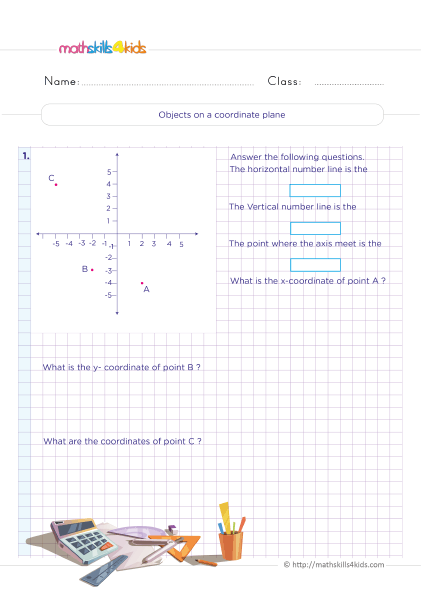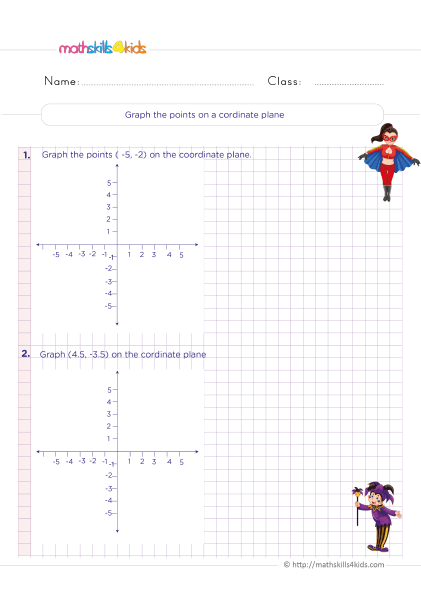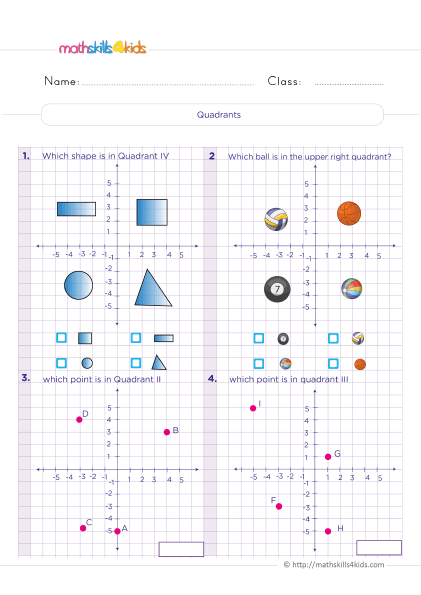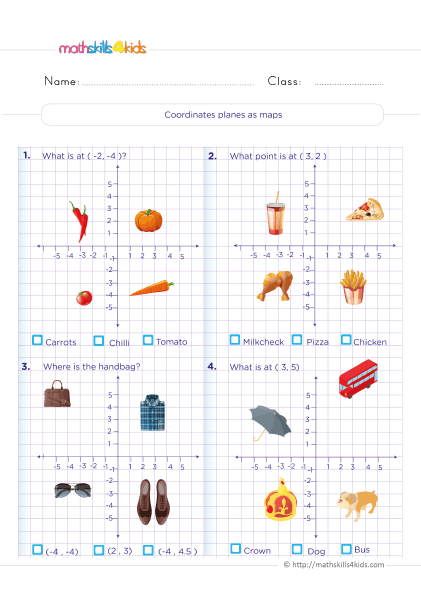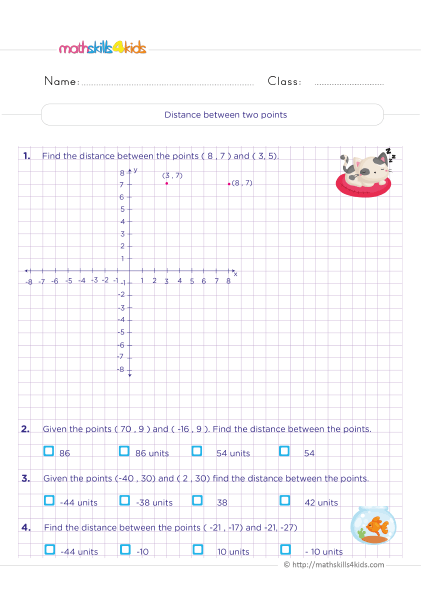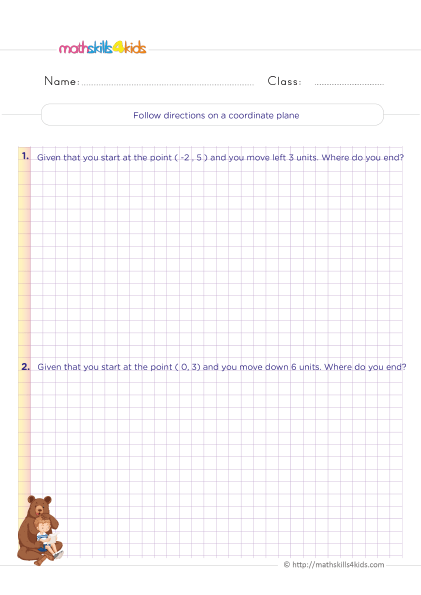6th Grade coordinate plane worksheets: Download now
Hello teachers and parents! If your students still struggle to understand the concept of coordinate plane graphing, you can help them by downloading these 6th Grade coordinate plane worksheets from Mathskills4kids.com for fun and engaging practice.
-
In addition, this article aims to make learning interactive and fun by providing simple activities and games to practice graphing on a coordinate plane. We will also provide simple tips and tricks helpful in quickly mastering coordinate plane problems.
Also, apart from Mathskills4kids, we will include more resources and websites with coordinate plane activities that you can download and use with your children at home or in the classroom to boost their math skills.
Coordinate plane resources to reinforce 6th Grade graphing concepts with fun.
Do you want to help your 6th-graders master the skill of graphing on a coordinate plane? Do you want to make learning math fun and engaging for them? If you answered yes, then you are in the right place! In this article, we will share some fun coordinate plane resources that you can use to reinforce 6th Grade graphing concepts and skills.
Mathskills4kids.com, Mathisfun.com, and Math-salamanders.com are just a few resources among many in this article, with fun activities, games, worksheets, videos, etc., that will make graphing a breeze for your 6th-graders. Let's dive in!
-
BROWSE THE WEBSITE
-
DOWNLOAD FREE WORKSHEETS
-
-
GRADE 6 MATH TOPICS
- Whole numbers
- Multiplication
- Division
- Exponents and square roots
- Number theory
- Decimals
- Add & subtract decimals
- Multiply & divide decimals
- Fractions & mixed numbers
- Add & subtract fractions
- Multiply fractions
- Divide fractions
- Integers
- Operations with integers
- Mixed operations
- Rational numbers
- Problems solving
- Ratio & proportions
- Percentages
- Measuring units
- Money math
- Consumer math
- Telling time
- Coordinate graph
- Algebraic expressions
- One step equations
- Solve & graph inequalities
- Two-step equations
- 2D Geometry
- Symmetry & transformation
- 3D Shapes
- Geometry measurement
- Data and Graphs
- Statistics
- Probability
-
Buying is supporting us!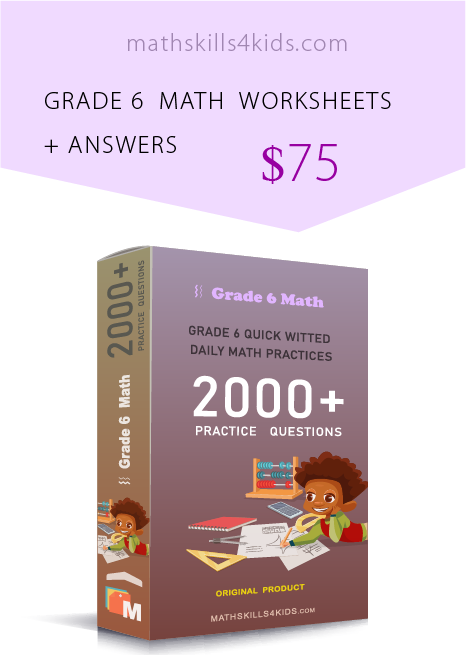
Buy Now...
-
-
What is a coordinate plane, and why is it important for 6th Grade Math?
A coordinate plane is a flat surface divided into four regions by two perpendicular lines called axes. The horizontal line is called the x-axis, and the vertical line is the y-axis. The point where the two axes meet is called the origin, and it has the coordinates (0, 0).
A coordinate plane is used to locate points in space using numbers called coordinates. Each point on the plane has a pair of coordinates that tells us how far it is from the origin along the x-axis and the y-axis. The pair of coordinates is written as (x, y), called an ordered pair.
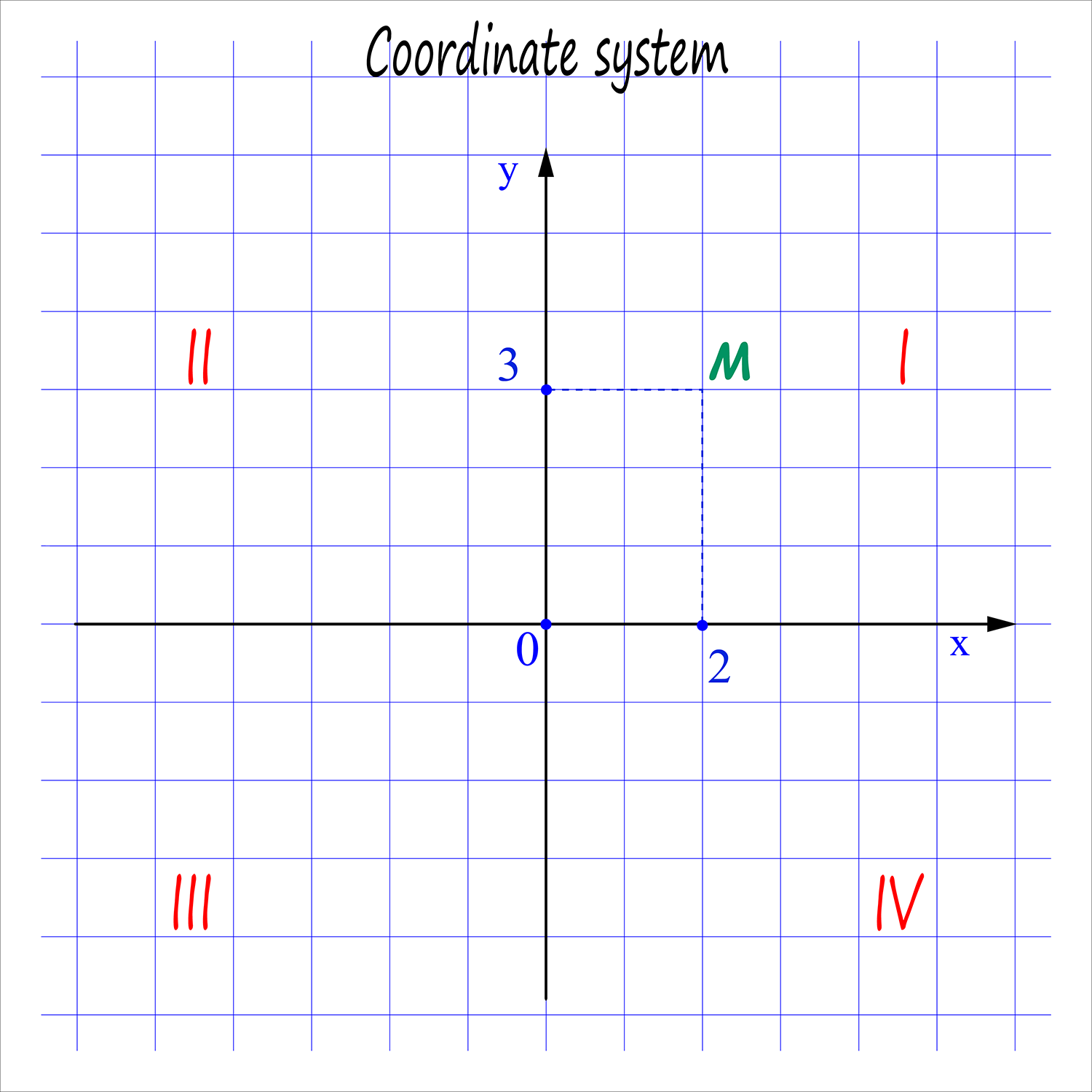
A coordinate plane system A coordinate plane is important for 6th-grade math because it helps students visualize and understand the relationship between two variables. For example, if we want to compare the height and weight of different animals, we can use a coordinate plane to plot their data and see how they are related.
A coordinate plane also helps students learn how to graph different equations, such as linear, quadratic, and exponential.
Graphing equations on a coordinate plane helps students see how changing one variable affects another variable and how different equations have different shapes and properties.
-
Fun and easy ways to teach graphing with everyday objects
One of the best, fun, and easy ways to introduce graphing to your students is to use everyday objects they can relate to. For example:
- You can use a sheet of graph paper as a giant coordinate plane and have your students use sticky notes, stickers, or magnets to plot points on it.
- You can also use a floor mat with a grid and have your students stand on different points and name their coordinates.
- Another idea is to use a large piece of cardboard or poster board and draw a coordinate plane on it.
Then, you can use different objects, such as coins, buttons, or candies, to create shapes or patterns on the plane. You can ask your students to identify the coordinates of the vertices or the center of the shapes or patterns.
-
Learn how to divide a coordinate plane into four regions
Another vital concept your students will learn is how to divide a coordinate plane into four regions or quadrants. These regions are labeled with Roman numerals from I to IV and are separated by two perpendicular lines: the x-axis and the y-axis.
The x-axis is the horizontal line from left to right, and the y-axis is the vertical line from top to bottom. The point where these two lines meet is called the origin and has the coordinates (0, 0).
To divide a coordinate plane into four regions, draw a line through the origin parallel to the x-axis and another line through the origin parallel to the y-axis. These lines will create four regions, as shown below:

Coordinate plane's quadrants The region in the upper right corner is called quadrant I and has positive x-coordinates and y-coordinates.
The region in the upper left corner is quadrant II and has negative x-coordinates and positive y-coordinates.
The region in the lower left corner is called quadrant III and has negative x-coordinates and negative y-coordinates.
The region in the lower right corner is called quadrant IV and has positive x-coordinates and negative y-coordinates.
-
How to plot points on a coordinate plane using ordered pairs
To plot a point on a coordinate plane using an ordered pair, we need to follow these steps:
- Find the x-coordinate of the point and move along the x-axis from the origin until you reach that number. If the x-coordinate is positive, move to the right. If the x-coordinate is negative, move to the left.
- Find the y-coordinate of the point and move along the y-axis from the origin until you reach that number. If the y-coordinate is positive, move up. If the y-coordinate is negative, move down.
- Mark the point where you stopped on both axes with a dot or a cross.
- Label the point with its ordered pair.
For example, if we want to plot the point M (2, 3) on a coordinate plane, we need to do this:
- Find the x-coordinate of 2 and move along the x-axis from the origin to the right until we reach 2.
- Find the y-coordinate of 3 and move along the y-axis from the origin until we reach 3.
- Mark the point where we stopped on both axes with a dot or a cross.
- Label the point with its ordered pair (2, 3).
Here's what it looks like on a coordinate plane:

Plot a point on a coordinate plane -
Discover the magic of reflections on a coordinate plane
Another fun concept in the 6th Grade coordinate plane worksheets is the reflection of shapes or points on a coordinate plane. A reflection is a transformation that flips an object over a line of symmetry. A line of symmetry is a line that divides an object into two congruent parts. When an object is reflected over a line of symmetry, each point on the object has a corresponding point on the other side of the line that is equidistant from the line.
-
Measure the distance between two points on a coordinate plane
One of the most valuable skills 6th graders can learn from graphing is measuring the distance between two points on a coordinate plane. This can help them to determine how far apart two objects are, how long a line segment is, or how big a shape is.
But how do we measure the distance between two points on a coordinate plane? It's pretty simple as long as the points are aligned horizontally or vertically. Here's how:
- To measure the distance between two points aligned horizontally, subtract their x-coordinates. For example, if we have points A (3, 5) and B (7, 5), the distance between them is 7 - 3 = 4 units.
- To measure the distance between two vertically aligned points, subtract their y-coordinates. For example, if we have points C (2, 1) and D (2, 6), the distance between them is 6 - 1 = 5 units.
You can use a ruler or a number line to help your students visualize the distance between two aligned points. Here is an example:

In this example, the distance between points (8, 7) and (3, 7) is 8 - 3 = 5 units.
-
Explore the world with 6th Grade coordinate planes worksheets as maps
One of the most exciting applications of coordinate planes is to use them as maps. We can use coordinate planes to represent different locations on Earth or in space. We can also use coordinate planes to measure distances, angles, or directions between different points. For example, we can use a coordinate plane to represent a city map and use coordinates to locate different landmarks or buildings. We can also use a coordinate plane to represent a star map and use coordinates to identify different constellations or planets.
You can help your students explore the world with coordinate planes as maps by using worksheets, online games, or interactive tools.
-
Find the area and perimeter of squares and rectangles on a coordinate plane.
Another vital skill 6th-graders need to master is finding the area and perimeter of squares and rectangles on a coordinate plane. This skill will help them understand how to measure shapes and spaces in two dimensions.
To find the area and perimeter of a square or rectangle on a coordinate plane, we need to use the formulae:
- Area = length x width
- Perimeter = 2 x (length + width)
But how do we find the length and width of a square or rectangle on a coordinate plane? Here are the steps:
- Identify the vertices (corners) of the square or rectangle. They should be ordered pairs of coordinates, such as (x, y).
- Find the horizontal distance between two adjacent vertices. This is the length of the square or rectangle. To find the horizontal distance, subtract the x-coordinates of the two vertices.
- Find the vertical distance between two adjacent vertices. This is the width of the square or rectangle. To find the vertical distance, subtract the y-coordinates of the two vertices.
- Plug the length and width into the formulae for area and perimeter and simplify.
Let's try an example. Suppose we have a rectangle with vertices (2, 3), (2, 7), (6, 7), and (6, 3) on a coordinate plane. What is its area and perimeter?
- To find the length, we subtract the x-coordinates of two adjacent vertices: 6 - 2 = 4
- To find the width, we subtract the y-coordinates of two adjacent vertices: 7 - 3 = 4
- To find the area, we multiply the length and width: 4 x 4 = 16
- To find the perimeter, we add the length and width and multiply by 2: 2 x (4 + 4) = 16
So, the area of the rectangle is 16 square units, and the perimeter is 16 units.
-
Follow the clues and solve the mysteries on a coordinate plane
One of the most exciting applications of coordinate planes is to use them as maps. We can use coordinate planes to represent different locations on Earth or in space. We can also use coordinate planes to measure distances, angles, or directions between different points. For example, we can use a coordinate plane to represent a city map and use coordinates to locate different landmarks or buildings. We can also use a coordinate plane to represent a star map and use coordinates to identify different constellations or planets.
You can help your students explore the world with coordinate planes as maps by using worksheets, online games, or interactive tools.
-
Fun activities and games to practice graphing on a coordinate plane
One of the best ways to reinforce graphing concepts with your 6th-graders is to make it fun and interactive. Here are some ideas of activities and games that you can use to practice graphing on a coordinate plane with your students or kids:
- Coordinate Plane Battleship: This classic game can be adapted to practice graphing on a coordinate plane. You'll need two coordinate planes, one for each player, and some markers or stickers. Each player secretly plots five points on their coordinate plane and labels them with letters A-E. Then, they take turns guessing each other's points by calling out ordered pairs. If they hit one of their opponent's points, they mark it with an X on their coordinate plane. If they miss, they mark it with an O. The first player to hit all five of their opponent's points wins.
- Coordinate Plane Art: This creative activity can be done individually or in groups. You'll need some graph paper, some colored pencils or crayons, and some examples of pictures that can be drawn using ordered pairs. For example, you can use this website (https://www.math-salamanders.com/coordinate-plane-grid.html) to find examples of animals, shapes, letters, and numbers that can be drawn using ordered pairs. Then, you can give your students or kids some ordered pairs and ask them to plot them on graph paper and connect them with lines to form the picture.
You can also challenge them to create pictures using ordered pairs and share them with others.
- Coordinate Plane Treasure Hunt: This is a fun activity that can be done indoors or outdoors. You'll need index cards, tape, and small prizes or treats. Write an ordered pair and a clue to the next location on each index card.
For example, write (2, 4) and "Look under the couch." Then, tape the index cards in different locations around the house or the classroom according to their coordinates. For example, you can tape the card with (2, 4) under the couch, the card with (5,-3) on the fridge, and so on. Then, give your students or kids a coordinate plane and a starting point and ask them to follow the clues to find the treasure. You can make the treasure hunt as easy or hard as possible by choosing different coordinates and clues.
Bonus: More awesome resources to level up your 6th-graders' math skills
If you're looking for more ways to make coordinate planes fun and engaging for your 6th-graders, check out these fantastic resources that we've curated for you:
- Coordinate Plane Battleship: This is a classic game that students can play online or print out. Your students will have a blast trying to sink their opponent's ships by guessing their coordinates. This game helps reinforce the concept of ordered pairs and quadrants. You can find it here: https://www.bytelearn.com/math-grade-6/lesson-plan/Coordinate-Battleship.
- Coordinate Plane Art: This creative activity allows your students to create their own designs using coordinate planes. They can use graph paper or an online tool like Desmos to plot and connect points with lines. They can also color their designs and share them with others. This activity helps develop spatial reasoning and artistic skills. You can find some examples and instructions here: https://www.teacherspayteachers.com/browse/Search:coordinate+plane+art/free.
- Coordinate Plane Worksheets: These printable worksheets cover various topics related to coordinate planes, such as graphing points, finding distances, reflecting shapes, and more. They are suitable for different levels of difficulty and include answer keys. These worksheets help reinforce the skills and concepts learned in class. You can find them here: https://www.mathworksheets4kids.com/ordered-pairs.php.
-
-
Thank you for sharing the links of MathSkills4Kids.com with your loved ones. Your choice is greatly appreciated.
Conclusion: Application of Graphing Skills in Real-Life Situations
Coordinate planes are not only useful for math but also for many real-life situations. For example, we can use coordinate planes to:
- Map out locations and directions using GPS or compasses
- Analyze data and trends using graphs and charts
- Create art and animations using computer programs
- Design buildings and structures using geometry and engineering
- Play games and puzzles that involve logic and strategy
As you can see, coordinate planes are a powerful tool to help your 6th-graders explore the world fun and meaningfully. We hope you enjoyed this article and found valuable resources to enhance your teaching skills.
Happy graphing!
